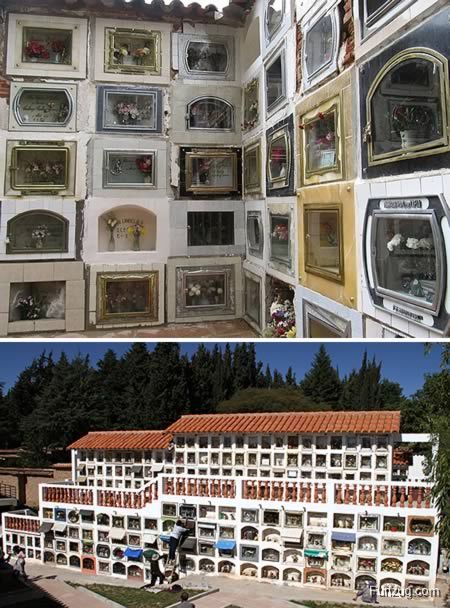2. Sucre's General Cemetery (Bolivia)
In Bolivia, at the Sucre's Cementerio General, the family pays for a vault upon their loved one's demise: $10,000 for seven years. After those seven years are up, the deceased's corpse is moved from the vault into the ground. And after twenty years in the ground, the remains are removed entirely. Seems kind of harsh, but still: there are probably very few people whose deaths need more than 27 years of mourning.
Men are often buried with their workmates, betraying how tightly bound a Bolivian's identity is to his profession. Here, they're not so much family men who happen to work as truck drivers; they're truck drivers who happen to have a family. In Sucre's cemetery, large common vaults owned by unions — coal miners, lawyers and teachers among them — occupy a lot of ground. Likewise, children aren't buried with their parents, but with other children under a large hill of white graves, which is both beautiful and sad. The kids' shrines are filled with Disney characters, coke bottles, toys and poems. Adults, too, have shrines filled with the things they loved — often tiny liquor bottles, or a pack of cigarettes.
There's a lot of history in Sucre's cemetery, as well. Among the many presidents buried here is Hilarión Daza, who sparked the disastrous War of the Pacific with Chile, which cost Bolivia its coastline.
 IMAGE CORNER
IMAGE CORNER Wallpapers/Cool Images
Wallpapers/Cool Images Arts and Paintings
Arts and Paintings Great Cemetery Art Sculptures
Great Cemetery Art Sculptures IMAGE CORNER
IMAGE CORNER Wallpapers/Cool Images
Wallpapers/Cool Images Arts and Paintings
Arts and Paintings Great Cemetery Art Sculptures
Great Cemetery Art Sculptures
